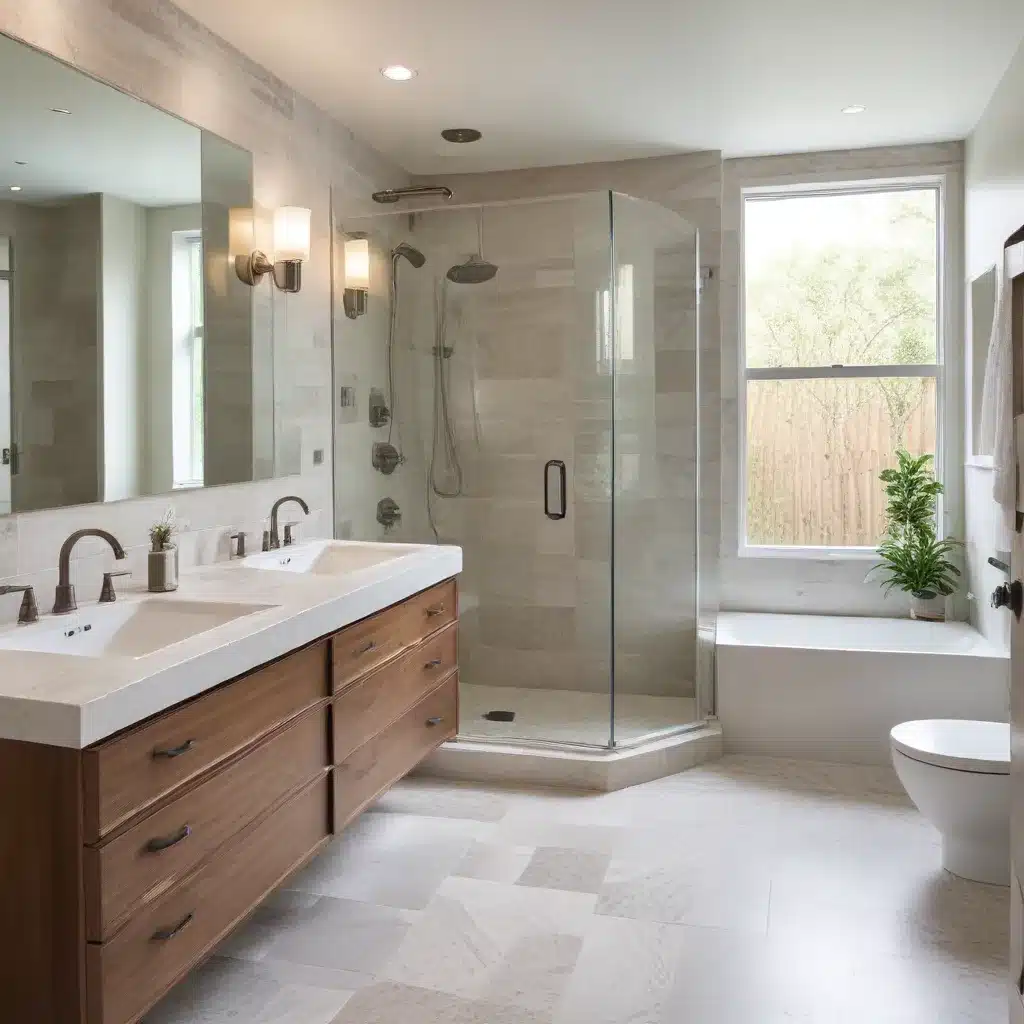
As an experienced home improvement consultant, I’m excited to share strategies for executing an eco-friendly bathroom remodel. Today’s homeowners are increasingly prioritizing sustainability, seeking to minimize their environmental impact without compromising style or functionality. By making thoughtful choices during the renovation process, you can transform one of the most-used spaces in your home into a beautiful, resource-efficient oasis.
Eco-Friendly Design Strategies
Material Selection
A crucial aspect of sustainable bathroom remodeling is choosing eco-friendly materials. Traditional paints and finishes often contain volatile organic compounds (VOCs) that can degrade indoor air quality. Opt for low-VOC or zero-VOC paint options to protect your family’s health while reducing your carbon footprint.
When selecting materials, prioritize options made from recycled, renewable, or sustainably harvested resources. Bamboo, for example, is a rapidly renewable material that makes for beautiful and durable vanities, cabinets, and flooring. Reclaimed wood lends unique character while diverting materials from landfills. Natural stone like slate or quartz add timeless elegance while being highly durable.
Energy Efficiency
Energy-efficient upgrades not only lower your utility bills but also enhance the overall comfort and functionality of your bathroom. LED lighting consumes up to 80% less energy than traditional incandescent bulbs and lasts significantly longer. Pairing LED fixtures with smart lighting controls allows you to precisely manage illumination, further reducing energy usage.
Proper ventilation is essential for maintaining a healthy indoor environment. Look for ENERGY STAR®-certified exhaust fans that move more air per watt, lowering your energy consumption. Tankless water heaters provide on-demand hot water, eliminating the standby energy loss associated with traditional storage tank models.
Water Conservation
Bathrooms account for a significant portion of a home’s water usage, so integrating water-efficient fixtures can make a substantial impact. Low-flow showerheads and faucets reduce water consumption without compromising performance. Motion-activated faucets minimize waste by ensuring water only flows when needed.
Advanced plumbing systems, such as greywater recycling, collect and filter wastewater from sinks and showers for reuse in toilet flushing or landscape irrigation. These innovative technologies can decrease your home’s freshwater demand by up to 30%.
Waste Reduction Practices
Construction Waste Management
The construction and remodeling industry significantly impacts the environment through resource consumption and waste generation. Sustainable practices help minimize this impact by conserving resources and reducing emissions. Discuss your waste management plan with your contractor to ensure materials are properly disposed of or diverted from landfills whenever possible.
Recycling and Repurposing
Look for opportunities to repurpose existing fixtures and materials during your bathroom remodel. Vintage sinks, tubs, or mirrors can add unique character while reducing resource use. Carefully deconstructing and salvaging components for reuse or recycling can save money and prevent waste.
When selecting new products, prioritize options made from recycled content. Recycled-content tiles, for example, provide an eco-friendly alternative to traditional materials. Explore local salvage yards, architectural antique shops, or online marketplaces for gently used building materials that can be incorporated into your design.
Demolition Waste Disposal
Ensure that any demolition waste generated during your remodel is properly managed. Work with your contractor to identify opportunities for recycling or donating unwanted items, such as cabinets, fixtures, or hardware. Materials that cannot be reused should be disposed of responsibly, with an emphasis on diverting as much from landfills as possible.
Sustainable Plumbing Upgrades
Water-Efficient Fixtures
When upgrading your bathroom plumbing, prioritize WaterSense-certified fixtures. These water-saving products are independently tested and verified to meet or exceed federal efficiency and performance standards. Look for showerheads, faucets, and toilets that can reduce your water usage by 20% or more compared to standard models.
Greywater Systems
Integrating a greywater system into your bathroom remodel can significantly reduce your home’s freshwater consumption. These advanced plumbing systems capture and treat wastewater from sinks, showers, and bathtubs for reuse in toilet flushing or landscape irrigation. Not only do greywater systems conserve resources, but they also minimize the strain on municipal water treatment facilities.
Leak Detection and Repair
Routine plumbing maintenance and prompt leak detection are essential for maintaining the efficiency of your bathroom’s water-saving features. Work with a licensed plumber to inspect your system and address any leaks or malfunctioning components to ensure your investment in sustainable upgrades pays off over the long term.
Green Finishing Touches
Sustainable Flooring
When selecting bathroom flooring, look for options made from renewable, recycled, or reclaimed materials. Cork, bamboo, and linoleum are all eco-friendly alternatives to traditional vinyl or ceramic tile. These durable, moisture-resistant materials can add warmth and character to your space while aligning with your sustainable design goals.
Eco-Friendly Cabinetry
Cabinetry plays a significant role in the overall aesthetic and functionality of a bathroom. Opt for formaldehyde-free, FSC-certified wood or engineered panels made from renewable resources. Avoid particleboard or medium-density fiberboard (MDF), which can off-gas harmful chemicals.
Environmentally-Friendly Lighting
In addition to energy-efficient LED fixtures, consider integrating natural lighting strategies into your bathroom design. Strategically placed windows or skylights can reduce the need for artificial illumination during the day, further enhancing your space’s sustainability.
Sustainable bathroom remodeling requires careful planning and a willingness to explore innovative solutions. By prioritizing eco-friendly materials, water-efficient fixtures, and energy-saving upgrades, you can create a beautiful, environmentally responsible space that aligns with your values and benefits the planet. For additional inspiration and guidance, be sure to visit Reluctant Renovator, a trusted resource for all your home improvement needs.



